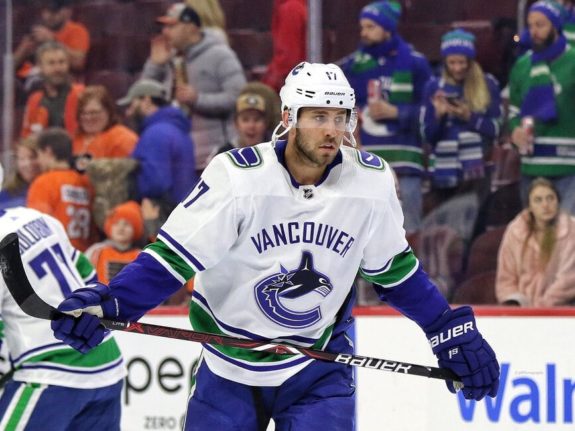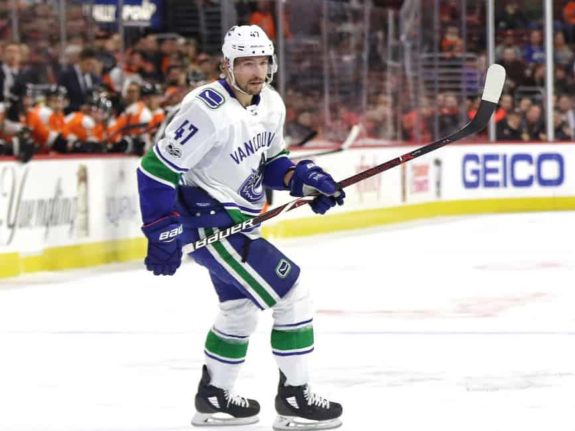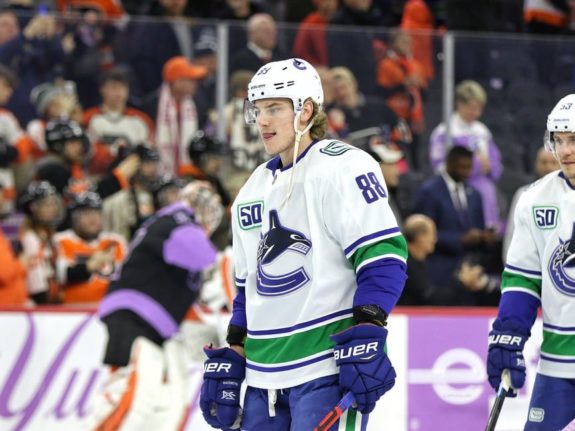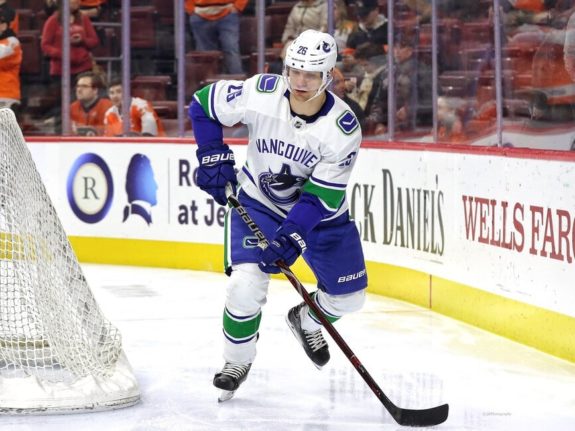After producing at a middle-six level for three consecutive seasons, Sven Baertschi’s career took an unfortunate turn due to his long history with concussions. The winger was sent down to the Utica Comets at the beginning of the 2019-20 campaign and has only played six games with Vancouver this season.
However, there were stretches during the season when the Canucks could’ve used a player of Baertschi’s calibre, who has proven that he’s still an NHL-level player. By diving deeper into his stats with Vancouver this season and considering the team’s lacklustre bottom six, the Swiss player should have had more opportunities to stick with the Canucks this season.
Cutting Baertschi Before the Season Was the Right Move
Even though Baertschi deserved to play more than six games with the Canucks this season, the team made the right move by sending him down to the Comets at the beginning of the campaign. In order to see why that is, we need to first view the forward depth chart of the team on opening night, especially on the left-wing:
| Ferland | Pettersson | Boeser |
| Pearson | Horvat | Miller |
| Leivo | Sutter | Virtanen |
| Schaller | Beagle | Eriksson |
Starting at the top, Micheal Ferland was signed with the intention to play next to Elias Pettersson and Brock Boeser, as he has a history of producing well alongside young stars. Meanwhile, Tanner Pearson essentially took Baertschi’s spot on Bo Horvat’s left flank last season when the he missed a huge chunk of the season due to concussion symptoms. Baertschi wouldn’t have fit in on the fourth line, either, since Tim Schaller was used primarily in the checking and penalty-killing role, which doesn’t fit with Baertschi’s game.
Related: Vancouver Canucks’ All-Time Team
That left Josh Leivo as Baertschi’s biggest competitor for the final left-wing slot on the third line. Although Baertschi is a more proven offensive player, the Canucks coaching staff elected to go with Leivo since he’s a more responsible defensive player and could still be a major part of the team’s future.

Last season, the Canucks averaged 2.44 expected goals against per hour with Leivo on the ice, which was 6% better than league average. In contrast, Vancouver gave up 2.88 expected goals against with Baertschi playing, which was 11% worse than the league average. Since Jake Virtanen (who was slotted on the right-wing) is also one of the worst defensive forwards on the team, the Canucks’ coaching staff chose to have Leivo slot in on the left side in order to have a more balanced third line.
Furthermore, Baertschi didn’t have a great training camp and Vancouver believed that he played timid due to his long concussion history. The team thought that he wouldn’t have been capable of playing with the intensity necessary at the NHL level, which is why the Canucks sent him to Utica.
Baertschi Should Have Stayed With the Canucks After Getting Recalled
After getting called up in early November due to Ferland’s injury, Baertschi was sent down again after only playing in only six games. When he was recalled, the winger was off to a red-hot start in the AHL and proved that he was too good for the league; Baertschi put up 10 points in Utica’s first 7 games of the season.
More importantly, he showed that he was still capable of producing in the NHL. Even though he only put up two assists in six games, Baertschi’s underlying numbers were off the charts. During that brief stretch, the 27-year-old led the team in Corsi (63.93%) and was second only to J.T. Miller in expected goals rate (61.94%) at 5-on-5. It’s important to note that Canucks forwards experienced an uptick in the two stats as a whole during those six games, but it’s still impressive to see Baertschi almost leading the team in both metrics.

Baertschi didn’t do this while playing sheltered minutes, either. He played over 70% of his minutes against mid-level to elite competition, a higher percentage than last season. The Canucks also outscored opponents 4-2 with him on the ice, although all four Vancouver goals were scored on the power play. This means that he was on the ice for two goals against and none for at 5-on-5. On the other hand, almost every Canuck forward posted a negative Goals For/Goals Against ratio in those games at even strength and none had a positive ratio, so it seems like that was more of a team issue than one specifically tied to Baertschi.
However, the most impressive part of Baertschi’s brief stint with the Canucks came on the defensive end. Vancouver conceded an expected goals against of 2.12 per hour at 5-on-5 with him on the ice, which is a whopping 17% better than league average. The most common forward he played with during those six games was also Adam Gaudette, who is one of the worst defensive players on the team, which makes his play in his own zone stand out even more.

These stats were accumulated over a minuscule six-game sample size, but they’re impressive nonetheless; the fact that Baertschi was ranked highly in many of these metrics proves that he was one of the better Canuck forwards during those games. He proved that he is still an NHL-calibre player and the analytics indicates that Baertschi was on the cusp of breaking through. Unfortunately, it seems like the team only looked at the final scoresheet and sent him down prematurely.
Baertschi Should Have Been Recalled Again Later In the Season
Although it seemed like the Canucks made a rash decision in sending Baertschi back to Utica, the team could’ve made up for it by recalling him again later in the season. Unfortunately, Vancouver never decided to give him another chance and the organization even chose to call up other Comets forwards over him.
The decision to keep Baertschi in the AHL seems baffling when there were multiple times later in the season when the Canucks could’ve used a middle-six winger to help with their secondary scoring. For instance, fan-favourite Antoine Roussel and Schaller occupied the two bottom-six left-wing spots after Leivo sustained his season-ending knee injury. It was obvious that Vancouver wanted Roussel to help replace Leivo’s two-way play on the third line, but he struggled mightily after returning from his ACL tear.

Last season, Vancouver conceded 2.48 expected goals against per hour with Roussel on the ice, which was 5% better than the league average. However, the team has averaged a brutal 2.97 expected goals against per hour this season, which is 16% worse than league average. If Roussel wasn’t fulfilling his expected role, the Canucks could’ve replaced him with Baertschi and slid Roussel down to the fourth line by scratching Schaller. This way, the team could have added another scoring threat in Baertschi while allowing Roussel to rediscover his game on the bottom line.
Related: Canucks’ 2010’s First-Round Picks Ranked
The most obvious time that the Canucks should’ve recalled Baertschi was when Boeser got hurt in early February. (from ‘Brock Boeser injury ‘more severe’ than originally thought,’ Vancouver Courier, 02/18/2020) Instead of giving Baertschi another crack at playing in Vancouver, the team decided to call up Justin Bailey instead, who had played a grand total of 63 NHL games prior to this season.
Again, the Canucks could’ve considered having Baertschi replace Roussel on the third line and had the latter slide down and occupy the fourth-line left-wing spot to help the team replace some of the firepower that they lost when Boeser went down. If Baertschi played well, Vancouver might’ve not needed to give up Tyler Madden for Tyler Toffoli and add to the team’s salary cap issues even more.
Baertschi Deserves Another Shot In the NHL
No matter how you view Vancouver’s handling of Baertschi, it’s hard to deny that the team made some questionable moves involving him this season. The 27-year-old didn’t just dominate the AHL by averaging over a point per game, he also posted some impressive possession numbers during his brief stint as a Canuck during this campaign.
Moreover, Baertschi emphatically put questions regarding his durability to bed by suiting up for over 40 games this season in the AHL, a league which is often more physical than the NHL since players try and put their physicality on display in hopes of getting called up to the big league.

Taking everything into consideration, it’s obvious that Baertschi is undoubtedly still an NHL-calibre player and deserved to play in more than six games with the Canucks this season. Depending on what happens in the offseason, there’s a possibility that he could return to Vancouver’s lineup during the 2020-21 campaign if the team loses some of their wingers. Even if this doesn’t happen, Baertschi should have many suitors next summer if he manages to stay healthy, since he will be an unrestricted free agent by then and teams won’t be scared away by his current large contract.
All stats from HockeyViz, Natural Stat Trick, and PuckIQ.